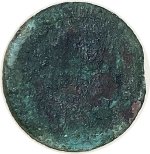I took pics of this coin and turned it 45 degrees to get four pics of one side and four of another. It was found on the edge of the Chesapeake Bay today in Maryland, the Deus II pulled it from 11"! The house was built ca 1690. We found very little else-except modern trash. NOW...this puppy is about 19 mm. It is very thin and weighs 1.6 grams. It is made of copper. Both sides have some de-lamination. There APPEARS to be some lettering around most of the edge. Ideas? I have found coins from as early as 1450 nearby. And no, it's not pretty.








Upvote
16






